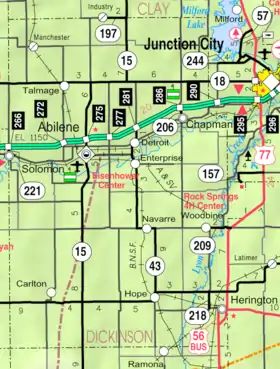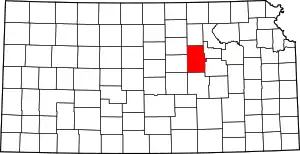Carlton, Kansas | |
|---|---|
 Location within Dickinson County and Kansas | |
 KDOT map of Dickinson County (legend) | |
| Coordinates: 38°41′12″N 97°17′35″W / 38.68667°N 97.29306°W[1] | |
| Country | United States |
| State | Kansas |
| County | Dickinson |
| Government | |
| • Type | Mayor–Council |
| Area | |
| • Total | 0.17 sq mi (0.44 km2) |
| • Land | 0.17 sq mi (0.44 km2) |
| • Water | 0.00 sq mi (0.00 km2) |
| Elevation | 1,316 ft (401 m) |
| Population | |
| • Total | 40 |
| • Density | 240/sq mi (91/km2) |
| Time zone | UTC-6 (CST) |
| • Summer (DST) | UTC-5 (CDT) |
| ZIP code | 67448 |
| Area code | 785 |
| FIPS code | 20-10675 [1] |
| GNIS ID | 2393748[1] |
Carlton is a city in Dickinson County, Kansas, United States.[1] As of the 2020 census, the population of the city was 40.[3]
History

Early history
For many millennia, the Great Plains of North America was inhabited by nomadic Native Americans. From the 16th century to 18th century, the Kingdom of France claimed ownership of large parts of North America. In 1762, after the French and Indian War, France secretly ceded New France to Spain, per the Treaty of Fontainebleau.
19th century
In 1802, Spain returned most of the land to France. In 1803, most of the land for modern day Kansas was acquired by the United States from France as part of the 828,000 square mile Louisiana Purchase for 2.83 cents per acre.
In 1854, the Kansas Territory was organized, then in 1861 Kansas became the 34th U.S. state. In 1857, Dickinson County was established within the Kansas Territory, which included the land for modern day Carlton.
Carlton was a station and shipping point on the Missouri Pacific Railroad.[4]
A post office was opened in Carlton in 1872, and remained in operation until it was discontinued in 1995.[5]
Geography
According to the United States Census Bureau, the city has a total area of 0.17 square miles (0.44 km2), all of it land.[6]
Demographics
| Census | Pop. | Note | %± |
|---|---|---|---|
| 1890 | 121 | — | |
| 1930 | 138 | — | |
| 1940 | 101 | −26.8% | |
| 1950 | 76 | −24.8% | |
| 1960 | 78 | 2.6% | |
| 1970 | 40 | −48.7% | |
| 1980 | 49 | 22.5% | |
| 1990 | 39 | −20.4% | |
| 2000 | 38 | −2.6% | |
| 2010 | 42 | 10.5% | |
| 2020 | 40 | −4.8% | |
| U.S. Decennial Census | |||
2010 census
As of the census[7] of 2010, there were 42 people, 16 households, and 14 families living in the city. The population density was 247.1 inhabitants per square mile (95.4/km2). There were 20 housing units at an average density of 117.6 per square mile (45.4/km2). The racial makeup of the city was 100.0% White.
There were 16 households, of which 37.5% had children under the age of 18 living with them, 81.3% were married couples living together, 6.3% had a female householder with no husband present, and 12.5% were non-families. 12.5% of all households were made up of individuals, and 6.3% had someone living alone who was 65 years of age or older. The average household size was 2.63 and the average family size was 2.86.
The median age in the city was 46.5 years. 28.6% of residents were under the age of 18; 0.0% were between the ages of 18 and 24; 19.1% were from 25 to 44; 26.1% were from 45 to 64; and 26.2% were 65 years of age or older. The gender makeup of the city was 52.4% male and 47.6% female.
2000 census
As of the census[1][8] of 2000, there were 38 people, 16 households, and 11 families living in the city. The population density was 232.0 inhabitants per square mile (89.6/km2). There were 20 housing units at an average density of 122.1 per square mile (47.1/km2). The racial makeup of the city was 100.00% White.
There were 16 households, out of which 31.3% had children under the age of 18 living with them, 62.5% were married couples living together, 6.3% had a female householder with no husband present, and 31.3% were non-families. 31.3% of all households were made up of individuals, and 6.3% had someone living alone who was 65 years of age or older. The average household size was 2.38 and the average family size was 2.91.
In the city, the population was spread out, with 23.7% under the age of 18, 5.3% from 18 to 24, 34.2% from 25 to 44, 23.7% from 45 to 64, and 13.2% who were 65 years of age or older. The median age was 39 years. For every 100 females, there were 100.0 males. For every 100 females age 18 and over, there were 107.1 males.
The median income for a household in the city was $33,125, and the median income for a family was $33,125. Males had a median income of $22,188 versus $13,750 for females. The per capita income for the city was $9,750. None of the population and none of the families were below the poverty line.
Education
The community is served by Chapman USD 473 public school district. The Chapman High School mascot is Chapman Fighting Irish.[9][10]
See also
References
- 1 2 3 4 5 6 U.S. Geological Survey Geographic Names Information System: Carlton, Kansas
- ↑ "2019 U.S. Gazetteer Files". United States Census Bureau. Retrieved July 24, 2020.
- 1 2 "Profile of Carlton, Kansas in 2020". United States Census Bureau. Archived from the original on November 13, 2021. Retrieved November 13, 2021.
- ↑ Blackmar, Frank Wilson (1912). Kansas: A Cyclopedia of State History, Embracing Events, Institutions, Industries, Counties, Cities, Towns, Prominent Persons, Etc. Standard Publishing Company. pp. 288.
- ↑ "Kansas Post Offices, 1828-1961 (archived)". Kansas Historical Society. Archived from the original on September 9, 2013. Retrieved June 8, 2014.
- ↑ "US Gazetteer files 2010". United States Census Bureau. Archived from the original on July 2, 2012. Retrieved July 6, 2012.
- ↑ "U.S. Census website". United States Census Bureau. Retrieved July 6, 2012.
- ↑ "U.S. Census website". United States Census Bureau. Retrieved January 31, 2008.
- ↑ USD 473
- ↑ Kansas School District Boundary Map Archived July 21, 2011, at the Wayback Machine
Further reading
- Carlton Area History: Carlton - Elmo - Holland, Dickinson County, Kansas; Carlton Book Committee; Bell Books; 1995.
External links
- Carlton - Directory of Public Officials
- Historic Images of Carlton, Special Photo Collections at Wichita State University Library
- Carlton city map, KDOT
